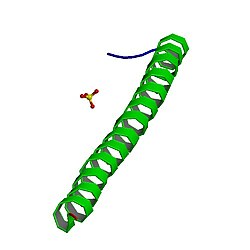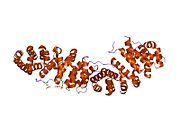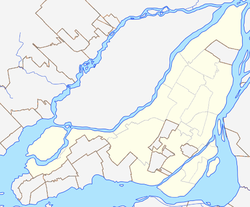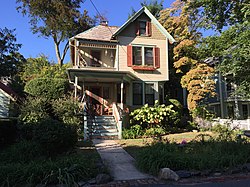선종성 대장균
Adenomatous polyposis coli선종성 용종성 대장균(APC)은 용종성 2.5(DP2.5)에서도 결실된 것으로 알려져 있으며 사람에게서 APC [4]유전자에 의해 암호화되는 단백질이다.APC 단백질은 베타-카테닌 농도를 조절하고 세포 접착에 관여하는 E-카드헤린과 상호작용하는 음성 조절기입니다.APC 유전자의 돌연변이는 대장암을 [5]일으킬 수 있다.
APC는 종양 억제 유전자로 분류된다.종양 억제 유전자는 암 종양을 일으킬 수 있는 세포의 통제되지 않은 성장을 막는다.APC 유전자에 의해 만들어진 단백질은 세포가 종양으로 발전할 수 있는지 여부를 결정하는 여러 세포 과정에서 중요한 역할을 한다.APC 단백질은 세포가 얼마나 자주 분열하는지, 조직 내의 다른 세포에 어떻게 부착하는지, 세포가 어떻게 분극하고 3D 구조의 [6]형태 형성하는지, 또는 세포가 조직 내에서 또는 조직으로부터 멀어지는지를 조절하는데 도움을 준다.이 단백질은 또한 세포 분열을 통해 생성된 세포의 염색체 수가 정확한지 확인하는데 도움을 준다.APC 단백질은 주로 다른 단백질, 특히 세포 부착과 신호 전달에 관여하는 단백질과의 연관성을 통해 이러한 작업을 수행합니다.특히 하나의 단백질인 베타-카테닌의 활성은 APC 단백질에 의해 제어된다(Wnt 시그널링 경로 참조).베타카테닌을 조절하면 세포분열을 자극하는 유전자가 너무 자주 활성화되는 것을 방지하고 세포의 과성장을 막을 수 있다.
인간 APC 유전자는 5번 염색체의 긴 팔뚝에 밴드 q22.2(5q22.2)로 위치한다.APC 유전자는 내부 리보솜 진입 부위를 포함하는 것으로 나타났다.APC 정형어는[7] 또한 완전한 게놈 데이터를 이용할 수 있는 모든 포유동물에서 확인되었다.
구조.
전장 인간 단백질은 (예측된) 분자량이 311646Da인 2,843개의 아미노산으로 구성되어 있다. 몇몇 N-말단 도메인은 독특한 원자론적 고해상도 복합구조에서 구조적으로 설명되었다.대부분의 단백질은 본질적으로 무질서할 것으로 예측된다.아미노산 800에서 2843까지 이 큰 예측 비정형 영역이 생체 내에서 지속되는지 아니면 아직 확인되지 않은 상호작용 [8]단백질과 함께 안정화 복합체를 형성할지는 알려지지 않았다.최근에는 APC 중심 주변의 돌연변이 클러스터 영역이 [9]체외에서 본질적으로 무질서하다는 것이 실험적으로 확인되었다.
암에서의 역할
대장암에서 가장 흔한 돌연변이는 APC의 불활성화이다.APC 불활성화 돌연변이가 없을 경우 대장암은 일반적으로 베타 카테닌에서 활성화 돌연변이를 일으키거나 RNF43에서 [10]불활성화 돌연변이를 일으킨다.APC의 돌연변이는 유전될 수 있고, 종종 DNA의 돌연변이를 복구할 수 없는 다른 유전자의 돌연변이의 결과로 체세포에서 산발적으로 발생할 수 있다.암이 발병하기 위해서는 두 가지 대립 유전자(APC 유전자의 복제)가 모두 돌연변이가 되어야 한다.APC 또는 β-catenin의 돌연변이는 암이 되기 위해 다른 돌연변이를 따라야 한다. 그러나, APC 불활성화 변이의 보균자의 경우 40세까지 대장암의 위험은 [5]거의 100%이다.
가족성 선종 용종증(FAP)은 APC [11]유전자의 유전적인 불활성화 돌연변이에 의해 발생한다.APC 유전자의 800개[citation needed] 이상의 돌연변이가 가족성 선종 용종의 고전적이고 감쇠된 유형을 가진 가족에서 확인되었다.이러한 돌연변이의 대부분은 비정상적으로 짧고 아마도 기능하지 않는 APC 단백질의 생성을 유발합니다.이 짧은 단백질은 암이 될 수 있는 용종의 형성을 초래하는 세포의 과성장을 억제할 수 없다.가족성 선종성 용종의 가장 흔한 돌연변이는 APC 유전자의 5가지 염기의 결실이다.이 돌연변이는 1309번 위치에서 시작하는 결과 APC 단백질의 아미노산 서열을 변화시킨다.
또 다른 돌연변이는 아슈케나지(동유럽과 중부 유럽) 유대인의 약 6%에 의해 전염된다.이 돌연변이는 APC 단백질(I1307K 또는 Ile1307Lys로도 표기됨)의 위치 1307에서 이소류신에 아미노산 리신이 치환되는 결과를 초래한다.이 변화는 처음에는 무해한 것으로 생각되었지만 최근 대장암의 위험이 10-20퍼센트 증가하는 것과 관련이 있는 것으로 나타났다.
증식 규제
(Adenomatous Polyposis Coli) APC 단백질은 일반적으로 20 AA 및 SAMP [12][13][14]반복과의 상호작용을 통해 글리코겐 합성효소 키나제 3-α 및 또는 베타(GSK-3α/β) 및 액신과 "파괴 복합체"를 형성한다.이 복합체는 세포질에서 세포 사이의 아데렌 접촉에서 분리된 β-카테닌을 결합할 수 있다.GSK-3β는 β-카테닌의 초기 인산화를 수행하는 카제인산화효소 1(CK1)의 도움으로 β-카테닌을 두 번째로 인산화할 수 있다.이것은 세포 프로테아솜에 의한 유비퀴티네이션 및 분해를 위한 β-카테닌을 목표로 한다.이것은 증식 유전자의 [15]전사인자로 작용하는 핵으로의 전이를 막는다.APC는 또한 PDZ 결합 도메인을 통해 미세관을 대상으로 하여 이들을 [16]안정화시키는 것으로 생각됩니다.APC 단백질의 불활성화는 예를 들어 복합체의[citation needed] 구조를 파괴하는 Wnt 신호를 통해 세포질에서 특정 연쇄 반응이 시작된 후에 발생할 수 있다.핵에서 그것은 무족/BCL9, TCF 및 Pygo와[citation needed] 복합된다.
APC가 β-catenin과 결합하는 능력은 SAMP [17]반복을 통해 Axin에 결합하는 것과 함께 파괴 복합체에서 단백질 역학적 기능의 필수적인 부분으로 간주되어 왔다.이러한 모델은 돌연변이 클러스터 영역에서 일반적인 APC 기능 돌연변이가 종종 여러 β-카테닌 결합 부위와 SAMP 반복을 제거한다는 관찰에 의해 입증되었다.그러나 Yamulla와 동료들의 최근 증거는 이러한 모델을 직접 테스트했으며 APC의 핵심 역학적 기능이 β-카테닌에 직접 결합할 필요는 없지만 [18]Axin과의 상호작용이 필요할 수 있음을 시사한다.연구진은 APC의 많은 β-카테닌 결합 부위가 단백질의 β-카테닌 파괴 효율을 증가시키지만 단백질의 역학적 기능에 절대적으로 필요한 것은 아니라는 가설을 세웠다.파괴단지에서 APC의 정확한 기계적 기능을 밝히기 위해서는 추가 연구가 분명히 필요하다.
돌연변이
APC의 돌연변이는 종종 [8]대장암과 같은 암에서 초기에 발생한다.가족성 선종 용종증(FAP) 환자는 생식계 돌연변이를 가지고 있으며 95%는 난센스/프레임시프트 돌연변이로 조기 정지 코돈으로 이어진다.돌연변이의 33%는 아미노산 1061-1309 사이에서 발생한다.체세포 돌연변이의 경우, 60% 이상이 돌연변이 클러스터 영역(1286–1513) 내에서 발생하며, 20AA 반복 중 1개를 제외한 모든 부분에서 축신 결합 부위의 손실을 초래한다.APC의 돌연변이는 β-카테닌 조절 상실, 세포 이동 변화 및 염색체 불안정성을 [10]초래한다.
신경학적 역할
로젠버그 외 연구진은 APC가 자율신경병, 알츠하이머병, 노화 관련 난청, 간질 및 정신분열증에 대한 의미 있는 발견인 뉴런 사이의 콜린 작동성 시냅스 조립을 지시한다는 것을 발견했다.(29)
상호 작용
APC(gene)는 다음과 상호작용하는 것으로 나타났습니다.

「 」를 참조해 주세요.
레퍼런스
- ^ a b c GRCm38: 앙상블 릴리즈 89: ENSMUSG00000005871 - 앙상블, 2017년 5월
- ^ "Human PubMed Reference:". National Center for Biotechnology Information, U.S. National Library of Medicine.
- ^ "Mouse PubMed Reference:". National Center for Biotechnology Information, U.S. National Library of Medicine.
- ^ Nishisho I, Nakamura Y, Miyoshi Y, Miki Y, Ando H, Horii A, Koyama K, Utsunomiya J, Baba S, Hedge P (August 1991). "Mutations of chromosome 5q21 genes in FAP and colorectal cancer patients". Science. 253 (5020): 665–9. Bibcode:1991Sci...253..665N. doi:10.1126/science.1651563. PMID 1651563.
- ^ a b Markowitz SD, Bertagnolli MM (December 2009). "Molecular origins of cancer: Molecular basis of colorectal cancer". The New England Journal of Medicine. 361 (25): 2449–60. doi:10.1056/NEJMra0804588. PMC 2843693. PMID 20018966.
- ^ Lesko AC, Goss KH, Yang FF, Schwertner A, Hulur I, Onel K, Prosperi JR (March 2015). "The APC tumor suppressor is required for epithelial cell polarization and three-dimensional morphogenesis". Biochimica et Biophysica Acta (BBA) - Molecular Cell Research. 1853 (3): 711–23. doi:10.1016/j.bbamcr.2014.12.036. PMC 4327896. PMID 25578398.
- ^ "OrthoMaM phylogenetic marker: APC coding sequence".[영구 데드링크]
- ^ a b Minde DP, Anvarian Z, Rüdiger SG, Maurice MM (2011). "Messing up disorder: how do missense mutations in the tumor suppressor protein APC lead to cancer?". Molecular Cancer. 10: 101. doi:10.1186/1476-4598-10-101. PMC 3170638. PMID 21859464.
- ^ Minde DP, Radli M, Forneris F, Maurice MM, Rüdiger SG (2013). "Large extent of disorder in Adenomatous Polyposis Coli offers a strategy to guard Wnt signalling against point mutations". PLOS ONE. 8 (10): e77257. Bibcode:2013PLoSO...877257M. doi:10.1371/journal.pone.0077257. PMC 3793970. PMID 24130866.
- ^ a b Bugter JM, Fenderico N, Maurice MM (October 2020). "Mutations and mechanisms of WNT pathway tumour suppressors in cancer". Nature Reviews. Cancer. 21 (1): 5–21. doi:10.1038/s41568-020-00307-z. PMID 33097916. S2CID 225058221.
- ^ "Familial Adenomatous Polyposis". The Lecturio Medical Concept Library. Retrieved 22 July 2021.
- ^ Rubinfeld B, Albert I, Porfiri E, Fiol C, Munemitsu S, Polakis P (May 1996). "Binding of GSK3beta to the APC-beta-catenin complex and regulation of complex assembly". Science. 272 (5264): 1023–6. Bibcode:1996Sci...272.1023R. doi:10.1126/science.272.5264.1023. PMID 8638126. S2CID 84899068.
- ^ Kishida S, Yamamoto H, Ikeda S, Kishida M, Sakamoto I, Koyama S, Kikuchi A (May 1998). "Axin, a negative regulator of the wnt signaling pathway, directly interacts with adenomatous polyposis coli and regulates the stabilization of beta-catenin". The Journal of Biological Chemistry. 273 (18): 10823–6. doi:10.1074/jbc.273.18.10823. PMID 9556553.
- ^ Nakamura T, Hamada F, Ishidate T, Anai K, Kawahara K, Toyoshima K, Akiyama T (June 1998). "Axin, an inhibitor of the Wnt signalling pathway, interacts with beta-catenin, GSK-3beta and APC and reduces the beta-catenin level". Genes to Cells. 3 (6): 395–403. doi:10.1046/j.1365-2443.1998.00198.x. PMID 9734785.
- ^ Leber MF, Efferth T (April 2009). "Molecular principles of cancer invasion and metastasis (review)". International Journal of Oncology. 34 (4): 881–95. doi:10.3892/ijo_00000214. PMID 19287945.
- ^ Wen Y, Eng CH, Schmoranzer J, Cabrera-Poch N, Morris EJ, Chen M, et al. (September 2004). "EB1 and APC bind to mDia to stabilize microtubules downstream of Rho and promote cell migration". Nature Cell Biology. 6 (9): 820–30. doi:10.1038/ncb1160. PMID 15311282. S2CID 29214110.
- ^ Stamos JL, Weis WI (January 2013). "The β-catenin destruction complex". Cold Spring Harbor Perspectives in Biology. 5 (1): a007898. doi:10.1101/cshperspect.a007898. PMC 3579403. PMID 23169527.
- ^ Yamulla RJ, Kane EG, Moody AE, Politi KA, Lock NE, Foley AV, Roberts DM (August 2014). "Testing models of the APC tumor suppressor/β-catenin interaction reshapes our view of the destruction complex in Wnt signaling". Genetics. 197 (4): 1285–302. doi:10.1534/genetics.114.166496. PMC 4125400. PMID 24931405.
- ^ Rosenberg MM, Yang F, Mohn JL, Storer EK, Jacob MH (August 2010). "The postsynaptic adenomatous polyposis coli (APC) multiprotein complex is required for localizing neuroligin and neurexin to neuronal nicotinic synapses in vivo". The Journal of Neuroscience. 30 (33): 11073–85. doi:10.1523/JNEUROSCI.0983-10.2010. PMC 2945243. PMID 20720115.
- ^ Kawasaki Y, Senda T, Ishidate T, Koyama R, Morishita T, Iwayama Y, Higuchi O, Akiyama T (August 2000). "Asef, a link between the tumor suppressor APC and G-protein signaling". Science. 289 (5482): 1194–7. Bibcode:2000Sci...289.1194K. doi:10.1126/science.289.5482.1194. PMID 10947987.
- ^ Nakamura T, Hamada F, Ishidate T, Anai K, Kawahara K, Toyoshima K, Akiyama T (June 1998). "Axin, an inhibitor of the Wnt signalling pathway, interacts with beta-catenin, GSK-3beta and APC and reduces the beta-catenin level". Genes to Cells. 3 (6): 395–403. doi:10.1046/j.1365-2443.1998.00198.x. PMID 9734785.
- ^ Kaplan KB, Burds AA, Swedlow JR, Bekir SS, Sorger PK, Näthke IS (April 2001). "A role for the Adenomatous Polyposis Coli protein in chromosome segregation". Nature Cell Biology. 3 (4): 429–32. doi:10.1038/35070123. PMID 11283619. S2CID 12645435.
- ^ a b Su LK, Vogelstein B, Kinzler KW (December 1993). "Association of the APC tumor suppressor protein with catenins". Science. 262 (5140): 1734–7. Bibcode:1993Sci...262.1734S. doi:10.1126/science.8259519. PMID 8259519.
- ^ Kucerová D, Sloncová E, Tuhácková Z, Vojtechová M, Sovová V (December 2001). "Expression and interaction of different catenins in colorectal carcinoma cells". International Journal of Molecular Medicine. 8 (6): 695–8. doi:10.3892/ijmm.8.6.695. PMID 11712088.
- ^ Tickenbrock L, Kössmeier K, Rehmann H, Herrmann C, Müller O (March 2003). "Differences between the interaction of beta-catenin with non-phosphorylated and single-mimicked phosphorylated 20-amino acid residue repeats of the APC protein". Journal of Molecular Biology. 327 (2): 359–67. doi:10.1016/S0022-2836(03)00144-X. PMID 12628243.
- ^ Davies G, Jiang WG, Mason MD (April 2001). "The interaction between beta-catenin, GSK3beta and APC after motogen induced cell-cell dissociation, and their involvement in signal transduction pathways in prostate cancer". International Journal of Oncology. 18 (4): 843–7. doi:10.3892/ijo.18.4.843. PMID 11251183.
- ^ Ryo A, Nakamura M, Wulf G, Liou YC, Lu KP (September 2001). "Pin1 regulates turnover and subcellular localization of beta-catenin by inhibiting its interaction with APC". Nature Cell Biology. 3 (9): 793–801. doi:10.1038/ncb0901-793. PMID 11533658. S2CID 664553.
- ^ a b c Homma MK, Li D, Krebs EG, Yuasa Y, Homma Y (April 2002). "Association and regulation of casein kinase 2 activity by adenomatous polyposis coli protein". Proceedings of the National Academy of Sciences of the United States of America. 99 (9): 5959–64. Bibcode:2002PNAS...99.5959K. doi:10.1073/pnas.092143199. PMC 122884. PMID 11972058.
- ^ Satoh K, Yanai H, Senda T, Kohu K, Nakamura T, Okumura N, Matsumine A, Kobayashi S, Toyoshima K, Akiyama T (June 1997). "DAP-1, a novel protein that interacts with the guanylate kinase-like domains of hDLG and PSD-95". Genes to Cells. 2 (6): 415–24. doi:10.1046/j.1365-2443.1997.1310329.x. PMID 9286858.
- ^ Eklof Spink K, Fridman SG, Weis WI (November 2001). "Molecular mechanisms of beta-catenin recognition by adenomatous polyposis coli revealed by the structure of an APC-beta-catenin complex". The EMBO Journal. 20 (22): 6203–12. doi:10.1093/emboj/20.22.6203. PMC 125720. PMID 11707392.
- ^ a b Daniel JM, Reynolds AB (September 1995). "The tyrosine kinase substrate p120cas binds directly to E-cadherin but not to the adenomatous polyposis coli protein or alpha-catenin". Molecular and Cellular Biology. 15 (9): 4819–24. doi:10.1128/mcb.15.9.4819. PMC 230726. PMID 7651399.
- ^ Makino K, Kuwahara H, Masuko N, Nishiyama Y, Morisaki T, Sasaki J, Nakao M, Kuwano A, Nakata M, Ushio Y, Saya H (May 1997). "Cloning and characterization of NE-dlg: a novel human homolog of the Drosophila discs large (dlg) tumor suppressor protein interacts with the APC protein". Oncogene. 14 (20): 2425–33. doi:10.1038/sj.onc.1201087. PMID 9188857.
- ^ Jimbo T, Kawasaki Y, Koyama R, Sato R, Takada S, Haraguchi K, Akiyama T (April 2002). "Identification of a link between the tumour suppressor APC and the kinesin superfamily". Nature Cell Biology. 4 (4): 323–7. doi:10.1038/ncb779. PMID 11912492. S2CID 10745049.
- ^ Su LK, Burrell M, Hill DE, Gyuris J, Brent R, Wiltshire R, Trent J, Vogelstein B, Kinzler KW (July 1995). "APC binds to the novel protein EB1". Cancer Research. 55 (14): 2972–7. PMID 7606712.
- ^ Nakamura M, Zhou XZ, Lu KP (July 2001). "Critical role for the EB1 and APC interaction in the regulation of microtubule polymerization". Current Biology. 11 (13): 1062–7. doi:10.1016/S0960-9822(01)00297-4. PMID 11470413. S2CID 14122895.
- ^ Shibata T, Gotoh M, Ochiai A, Hirohashi S (August 1994). "Association of plakoglobin with APC, a tumor suppressor gene product, and its regulation by tyrosine phosphorylation". Biochemical and Biophysical Research Communications. 203 (1): 519–22. doi:10.1006/bbrc.1994.2213. PMID 8074697.
- ^ Liu J, Stevens J, Rote CA, Yost HJ, Hu Y, Neufeld KL, White RL, Matsunami N (May 2001). "Siah-1 mediates a novel beta-catenin degradation pathway linking p53 to the adenomatous polyposis coli protein". Molecular Cell. 7 (5): 927–36. doi:10.1016/S1097-2765(01)00241-6. PMID 11389840.
- ^ Li Q, Dashwood RH (October 2004). "Activator protein 2alpha associates with adenomatous polyposis coli/beta-catenin and Inhibits beta-catenin/T-cell factor transcriptional activity in colorectal cancer cells". The Journal of Biological Chemistry. 279 (44): 45669–75. doi:10.1074/jbc.M405025200. PMC 2276578. PMID 15331612.
- ^ Zumbrunn J, Kinoshita K, Hyman AA, Näthke IS (January 2001). "Binding of the adenomatous polyposis coli protein to microtubules increases microtubule stability and is regulated by GSK3 beta phosphorylation". Current Biology. 11 (1): 44–9. doi:10.1016/S0960-9822(01)00002-1. PMID 11166179. S2CID 15004529.
- ^ Tickenbrock L, Cramer J, Vetter IR, Muller O (August 2002). "The coiled coil region (amino acids 129-250) of the tumor suppressor protein adenomatous polyposis coli (APC). Its structure and its interaction with chromosome maintenance region 1 (Crm-1)". The Journal of Biological Chemistry. 277 (35): 32332–8. doi:10.1074/jbc.M203990200. PMID 12070164.
추가 정보
- Cohen MM (November 2003). "Molecular dimensions of gastrointestinal tumors: some thoughts for digestion". American Journal of Medical Genetics Part A. 122A (4): 303–14. doi:10.1002/ajmg.a.20473. PMID 14518068. S2CID 9546199.
- Fearnhead NS, Britton MP, Bodmer WF (April 2001). "The ABC of APC". Human Molecular Genetics. 10 (7): 721–33. doi:10.1093/hmg/10.7.721. PMID 11257105.
- Fodde R (May 2002). "The APC gene in colorectal cancer". European Journal of Cancer. 38 (7): 867–71. doi:10.1016/S0959-8049(02)00040-0. PMID 11978510.
- Goss KH, Groden J (May 2000). "Biology of the adenomatous polyposis coli tumor suppressor". Journal of Clinical Oncology. 18 (9): 1967–79. doi:10.1200/JCO.2000.18.9.1967. PMID 10784639.
- Järvinen HJ, Peltomäki P (January 2004). "The complex genotype-phenotype relationship in familial adenomatous polyposis". European Journal of Gastroenterology & Hepatology. 16 (1): 5–8. doi:10.1097/00042737-200401000-00002. PMID 15095846. S2CID 20780391.
- Lal G, Gallinger S (June 2000). "Familial adenomatous polyposis". Seminars in Surgical Oncology. 18 (4): 314–23. doi:10.1002/(SICI)1098-2388(200006)18:4<314::AID-SSU6>3.0.CO;2-9. PMID 10805953.
- van Es JH, Giles RH, Clevers HC (March 2001). "The many faces of the tumor suppressor gene APC". Experimental Cell Research. 264 (1): 126–34. doi:10.1006/excr.2000.5142. PMID 11237529.
- Rosenberg MM, Yang F, Giovanni M, Mohn JL, Temburni MK, Jacob MH (June 2008). "Adenomatous polyposis coli plays a key role, in vivo, in coordinating assembly of the neuronal nicotinic postsynaptic complex". Molecular and Cellular Neurosciences. 38 (2): 138–52. doi:10.1016/j.mcn.2008.02.006. PMC 2502068. PMID 18407517.











